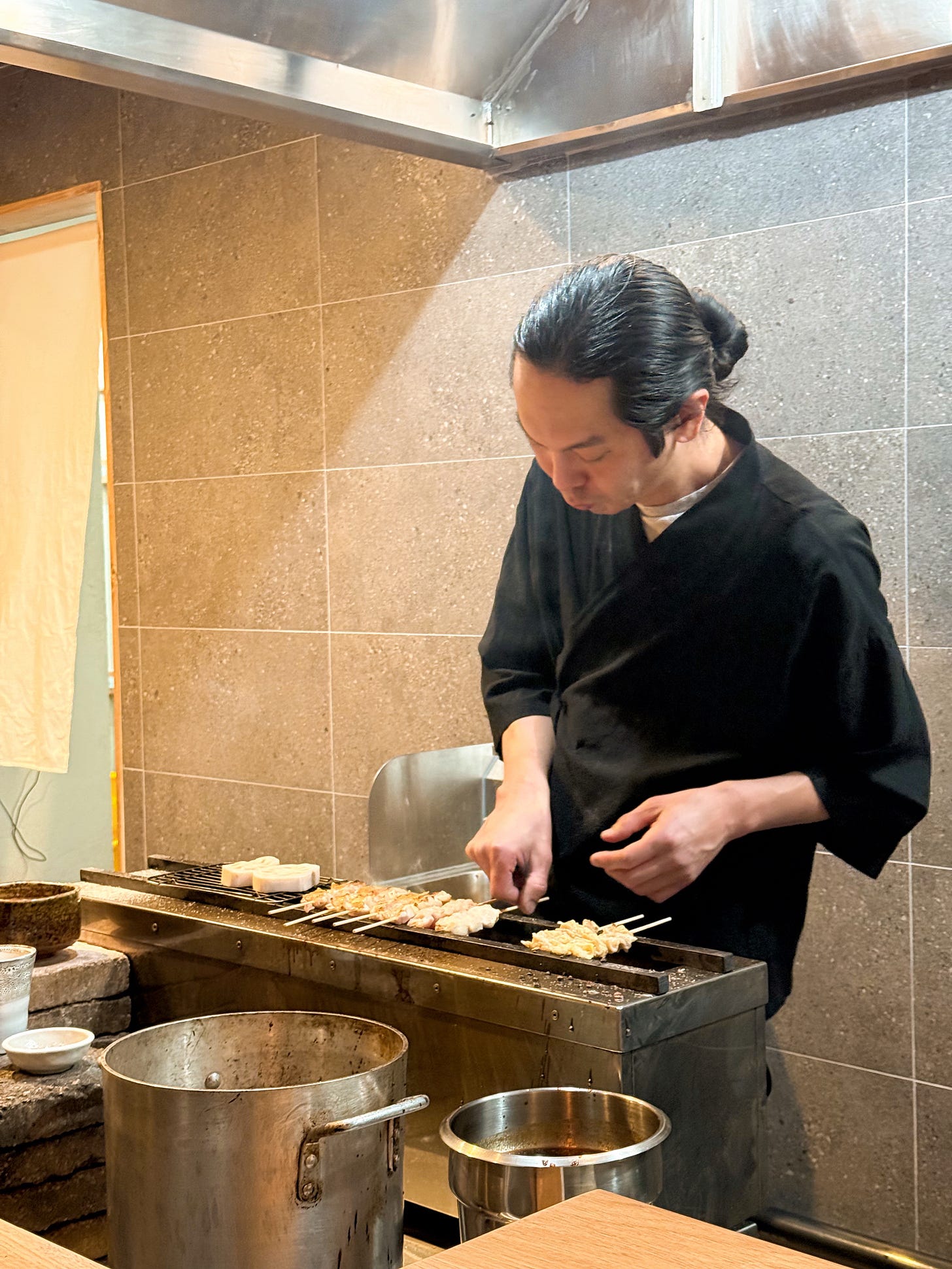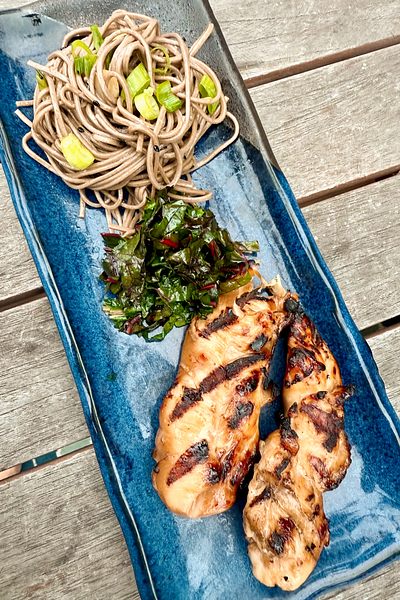Since January, I have been dreaming about grilled chicken. But not just any grilled chicken. Yakitori.
It was my husband’s birthday and I was looking for a different kind of dinner out. A newly opened yakitori restaurant - a barely marked storefront in a strip mall next to a hot wings shop and across from a Discount Tire - fit the bill. That Yakitori Tsuta, with its six counter seats, one chef and one waiter, exists in the mecca of Asian food for San Diego county was credentials enough. A ten-minute drive north from downtown, the district of Convoy Street was already my go-to for Shanghainese xiao long bao, Laotian grilled sausages, and the best Vietnamese sugarcane grilled shrimp south of Orange County. If a restaurant could devote itself to grilling chicken parts in the Japanese way, this had to be the place.
Yakitori, literally “grilled chicken”, is an art. Given the right artist - a chef devoted to the craft – plus quality ingredients and an audience willing to pay for the performance, it absolutely makes sense to spend an evening at the counter of a guy manning a charcoal grill. Call it chicken theater.
The chef, Tatsuro Tsuchiya, hair pulled back in a neat ponytail, greeted us with a kind smile from behind the deep charcoal grill he brought from Japan. Sipping dry sake and nibbling on pickled vegetables from Chino Farms, we watched as he dipped bite-sized pieces of chicken thigh skewered with leeks into a vat of sauce before placing it back on the grill alongside skewers of chicken skin folded like accordions, thimble-sized quail eggs, and maroon knobs of liver. It was a two-hour marathon of grilling chicken parts, where every morsel tasting uniquely of itself, perfectly cooked, yet all basted with the exact same sauce.
Our four fellow diners slurped down a last course of ramen floating in a rich chicken broth made of the bones of all those chickens, our four fellow diners rushed out, eager to get to another appointment, while my husband and I lingered over our last sips of broth and a bonus “dessert” chicken thigh. Watching the chef dip the skewer, as he had been doing all evening, and return it to the grill, I asked him what was in the mystery vat, the sauce that was lending all the skewers a subtly sweet, salty, umami.
He smiled, the kind way he had been all night but now tinged mischievous nonchalance. “Soy sauce, mirin, sake, sugar.”
“That’s all? So, like a teriyaki sauce.” I had the basic ingredients on hand at home. Immediately I began to picture recreating this dinner, dreams of a summer of smoky skewers hot off the grill.
“Oh and some of the chicken soup.”
Ah that broth, the one with the ramen, was so rich, a spoonful could have driven a cold away.
I wouldn’t be making yakitori at home, at least not the way the chef here made it, that soup being the secret to his sauce. But the basic balance of ingredients was the same as I had been using to make teriyaki sauce, and that was a sauce I knew something about. For months leading up to that dinner I had been experimenting with different recipes online and from cookbooks. It must be our Westernizing of everything, but most teriyaki sauce recipes I found, while following the same basic combination of sake, mirin and soy, use a heavy hand on the sugar, veering toward corn syrup consistency and achingly sweet.
Finally, an old cookbook delivered what I had been searching for. First published in 1980, Japanese Cooking, A Simple Art, by Shizuo Tsuji, included a recipe for teriyaki sauce that leaned into balance and simplicity, not overpowered by sugar. The rest was in the cooking technique.
I have been cooking with a version of that basic recipe since. Occasionally I will tweak it to pump up the flavor with grated ginger or a clove of garlic. Once simmered, the sauce is at the ready for salmon, chicken, yellowtail, or whatever protein catches my eye in the weeks to come.
With summer upon us on the grill fired up, now seemed like the appropriate time to test it on the grill. A deal on chicken tenderloins at the market had me set up for the perfect grill sized skewers. Since I would not be engaging in a 2-hour marathon of grilled chicken parts, rather than dipping in the vat of sauce, I simply marinated the thin strips for an hour before cooking. I had not been to Chino Farms, but I had some lovely chard from our own garden that I threw on the grill besides the skewers over indirect heat, so they could wilt and absorb some of the smokiness without charring. A cold soba noodle salad rounded out the meal.
I will be the first to admit that my version of yakitori is not traditional. For starters, I would like to have one mother sauce I can use for teriyaki salmon, made in a frying pan, as well as chicken skewers, on the grill. In her introduction to Japanese Cooking, famed food writer M.F.K. Fisher wrote, “As we come to know and use many of the finer things about traditional Japanese ryōri, therefore, Westerners can… adjust themselves to some shifts in pattern and even in behavior without losing their own identity at the table.” She goes on to say, “… we can adjust to all this, and we must simplify our cooking just as the Japanese have done, by learning a few more of its complexities….”
Thinking back to Chef Tatsuro Tsuchiya standing over his charcoal grill, basting parts of chicken in the same basic ingredients as every teriyaki and yakitori sauce that has come before, yet elevating it to another level, I wonder if anything better exemplifies both the simplicity and complexity of Japanese cooking than such a sauce. At the same time, I think Fisher would approve of my adjustment: one sauce for all manner of teriyaki and yakitori, a quick marinade rather than saucy plunge for the grill, while removing much of the sugar to be more in line with tradition. As the subtitle of the cookbook says, at its best, yakitori is a “simple art”.
Recipe…
Teriyaki Sauce
Makes: 1 ½ cups
½ cup sake
½ cup mirin (Japanese sweet cooking wine)
½ cup dry sake
1 T. sugar
1 T. grated ginger (optional)
1 grated garlic clove (optional)
In a small saucepan bring soy sauce, mirin, sake and sugar with optional ginger and garlic to a simmer over medium heat. Let cook for five minutes to reduce slightly and cook off the alcohol. Let cool before using. Can be stored in an airtight container for weeks.
Chicken Tender Yakitori with Smoked Chard and Cold Soba Salad
Serves: 4
Time: 30 minutes plus 1 hr. marinating
1 ½ lb. chicken tenders
½ cup teriyaki sauce
½ tsp. black pepper, ground
12 oz./ 4 packs soba noodles
3 T. grapeseed oil plus more for grilling
6 T. sesame oil
¼ c soy sauce or tamari
2 T. rice wine vinegar
2 T. honey
2 green onions, finely sliced
1 T. toasted sesame seeds
1 bunch Swiss chard, stems removed and reserved
Mix chicken tenders with teriyaki sauce and black pepper in a non-reactive bowl or baking dish. Cover and refrigerate for at least one hour but no more than 2.
Meanwhile, bring a large pot of water to a boil. Cook soba according to package directions until al dente. Drain and immediately rinse under cold water until cool to stop the cooking. While soba is cooking, in a large bowl whisk together 2 T. grapeseed oil, sesame oil, soy sauce, rice wine vinegar, and honey. When soba is cooked and cooled, add to the dressing along with the green onions and sesame seeds tossing to mix.
When chicken is done marinating, heat a grill over medium high. Skewer chicken tenders onto pre-soaked bamboo skewers or metal skewers and place on a sheet pan brushed with grapeseed oil. Brush additional oil on chicken. In a medium bowl, toss chard leaves with 1 T. grapeseed oil.
Place skewers at an angle on the grill for best grill marks, cooking for about 3-4 minutes per side. While chicken is cooking, grill chard leaves over low or indirect heat, working batches if you only have a small grill. This will take about 1 -2 two minutes per leaf to wilt (careful to not char though some crispy edges are fine). Transfer chard to a cutting board, making a small stack. When all chard is cooked, cut the stack crosswise into a chiffonade. Put shredded chard back in the bowl with a pinch of salt and toss to combine then mix in with the soba noodles or serve separately as a small mound beside noodles and a couple of chicken skewers.
What else can you do with teriyaki sauce?
Pan sear salmon with salt and pepper and neutral oil. When medium doneness, pour off excess oil then add teriyaki sauce to the pan, turning salmon to coat in the sauce for another 1-2 minutes.
Broil yellowtail collar, basting with the teriyaki sauce during the final minute of cooking.
Marinate button mushrooms for 30 minutes in teriyaki sauce. Thread onto skewers and grill for 10 - 15 minutes until cooked through.
To Drink…
Au Couer des Roches Pouilly-Fuissé, Burgundy, France 2022
Since this dish goes easy on the sweetness, pairing options are more plentiful that a store bought sauce might allow for. I would go with a Chardonnay from Southern Burgundy, like this Pouilly-Fuissé or a nice Mâcon. A fruity rosé could also be a nice pairing here. Forgo the ultra-light, Provence rosé here in favor of a more robust Tavel or Spanish rosado. For the red wine drinkers, the stemminess of a cru Beaujolais would be a nice pairing with the nutty soba noodles. Look for more fruit driven styles from Juliénas and Fleurie.
From $33.99 before discounts at Total Wine










The chicken looks delicious!
Mouth watering!